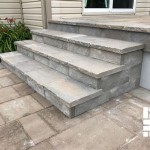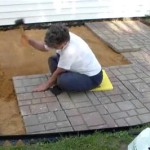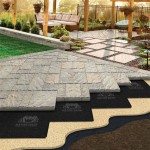How to Seal Outdoor Concrete Patio Paint
Painting an outdoor concrete patio can dramatically enhance its appearance, adding color, style, and protection from the elements. However, painted concrete is inherently vulnerable to wear and tear from weather, foot traffic, and UV exposure. Sealing the painted surface is crucial to preserving its beauty and extending its lifespan. This article provides a comprehensive guide on how to effectively seal a painted outdoor concrete patio, ensuring a durable and aesthetically pleasing result.
Understanding the Importance of Sealing Painted Concrete
Sealing painted concrete is not merely an optional step; it is an essential component of a successful patio transformation. The sealant acts as a protective barrier against numerous factors that can compromise the paint's integrity. Untreated painted concrete is susceptible to moisture penetration, leading to blistering, peeling, and eventual paint failure. Furthermore, exposure to sunlight can cause the paint to fade and crack over time. By applying a sealant, these detrimental effects are significantly minimized.
Beyond protection from the elements, sealant also offers a degree of resistance to abrasion and staining. Outdoor patios are subject to heavy foot traffic, furniture movement, and potential spills, all of which can damage the painted surface. A high-quality sealant creates a durable layer that can withstand these stresses, keeping the patio looking newer for longer. The type of sealant chosen also impacts the final look of the painted patio. Some sealants enhance the color of the paint, providing a richer, more vibrant appearance, while others offer a matte finish for a more subtle and natural look.
Therefore, understanding the benefits of sealing is the first step towards ensuring the longevity and aesthetics of a painted concrete patio. Proper selection and application of the sealant is vital to achieving desired results.
Selecting the Right Type of Concrete Sealer
Choosing the appropriate sealant is critical for the success of the project. Several different types of concrete sealers are available, each offering its own set of advantages and disadvantages. The selection process should consider the type of paint used, the intended use of the patio, and the desired aesthetic outcome. The most common types of sealants for painted concrete patios include acrylic sealers, polyurethane sealers, and epoxy sealers.
Acrylic Sealers: Acrylic sealers are a popular choice due to their ease of application and affordability. They offer good UV resistance and are generally water-based, making them environmentally friendly and easy to clean up. However, acrylic sealers typically have a shorter lifespan compared to other options and may require more frequent reapplication. They also offer less abrasion resistance, making them less suitable for patios with heavy foot traffic. Acrylic sealers are available in various finishes, from matte to glossy, allowing for flexibility in achieving the desired aesthetic.
Polyurethane Sealers: Polyurethane sealers are known for their excellent durability and resistance to abrasion and chemicals. They provide superior protection against weathering and are ideal for patios that experience heavy use or exposure to harsh conditions. Polyurethane sealers are available in both water-based and solvent-based formulas. Solvent-based polyurethanes generally offer greater durability but may have stronger odors and require more careful application and safety precautions. Water-based polyurethanes are lower in VOCs and easier to clean up, making them a more environmentally conscious option. They also come in varying degrees of sheen.
Epoxy Sealers: Epoxy sealers provide exceptional hardness and chemical resistance. They are often used in commercial and industrial settings due to their ability to withstand heavy loads and corrosive substances. While epoxy sealers offer excellent protection, they may not be the best choice for outdoor applications due to their susceptibility to UV degradation. Prolonged exposure to sunlight can cause epoxy sealers to yellow and become brittle. If considering an epoxy sealer for an outdoor painted patio, it is crucial to choose a UV-resistant formula. Epoxy sealers are commonly used as a base coat or primer before applying a more UV-resistant topcoat, such as a polyurethane sealant.
When selecting a sealer, it's crucial to review manufacturer specifications regarding compatibility with the specific type of paint used on the patio. Incompatible sealers can cause adhesion problems, discoloration, or even damage to the painted surface. It is also advisable to test the sealant in an inconspicuous area before applying it to the entire patio to ensure compatibility and achieve the desired aesthetic outcome.
Preparing the Painted Concrete Surface for Sealing
Proper surface preparation is paramount for successful sealant application. A clean, dry, and properly prepared surface ensures optimal adhesion and long-lasting protection. The steps involved in preparing the painted concrete surface include cleaning, patching, and allowing adequate drying time.
Cleaning: The first step is to thoroughly clean the painted concrete surface to remove any dirt, debris, grease, or other contaminants. Sweep the patio to remove loose debris, followed by washing the surface with a mild detergent and water solution. For stubborn stains or grease, use a concrete cleaner or degreaser specifically designed for painted surfaces. Rinse the patio thoroughly with clean water to remove all traces of the cleaning solution. Power washing can be used, but should be done cautiously and using lower pressure. Too much pressure can damage the paint, resulting in more preparation needed.
Patching: Inspect the painted surface for any cracks, chips, or other damage. Repair any imperfections with a concrete patching compound designed for painted surfaces. Follow the manufacturer's instructions for applying the patching compound, ensuring that it is properly cured and bonded to the existing surface. Once the patching compound has cured, sand it smooth to blend seamlessly with the surrounding painted area. Clean the patched area to remove any sanding debris.
Drying: Allow the painted concrete surface to dry completely before applying the sealant. Moisture trapped beneath the sealant can lead to adhesion problems, blistering, and premature failure. The drying time will depend on the weather conditions and the porosity of the concrete. Generally, it is recommended to allow at least 24 to 48 hours of drying time after cleaning or patching, or as outlined in the manufacturer's specifications of the sealant.
Ensuring that the painted concrete surface is meticulously cleaned, properly patched, and thoroughly dried is crucial for achieving a strong and durable bond with the sealant. Neglecting these preparation steps can compromise the sealant's performance and reduce its lifespan.
Applying the Concrete Sealer
Once the painted concrete surface is properly prepared, the next step is to apply the concrete sealer. The application process involves selecting the appropriate application tools, applying the sealant evenly, and allowing adequate drying time between coats. Factors such as ambient temperature, humidity, and wind conditions can also affect sealant application and drying times, so these should be considered.
Selecting Application Tools: The choice of application tools will depend on the type of sealant being used and the desired finish. Common application tools include paint rollers, brushes, and sprayers. For water-based sealants, a synthetic-bristle brush or roller is recommended. For solvent-based sealants, a natural-bristle brush or roller is often preferred, as synthetic bristles can be dissolved by the solvent. A sprayer can be used for both water-based and solvent-based sealants, providing even application and minimizing brush strokes. If using a sprayer, ensure it is specifically designed for applying concrete sealers and follow the manufacturer's instructions for proper setup and operation.
Applying the Sealant: Apply the sealant in thin, even coats, overlapping each stroke slightly to ensure complete coverage. Avoid applying the sealant too thickly, as this can lead to bubbling, peeling, or uneven drying. Follow the manufacturer's recommendations regarding the number of coats required and the drying time between coats. Typically, two coats of sealant are recommended for optimal protection. Allow the first coat to dry completely before applying the second coat. The drying time will depend on the type of sealant, the ambient temperature, and the humidity. Refer to the manufacturer's specifications for recommended drying times.
Drying and Curing: After applying the final coat of sealant, allow it to dry and cure completely before exposing the patio to foot traffic or furniture. The curing time will vary depending on the type of sealant and the environmental conditions. Generally, it is recommended to allow at least 24 to 72 hours of curing time. During the curing period, protect the patio from rain, direct sunlight, and other elements that could interfere with the curing process. Place caution tape or signs around the patio to prevent accidental use during the curing period.
Proper application of the concrete sealer, using the appropriate tools and techniques, is crucial for achieving a uniform and durable finish. Following the manufacturer's instructions regarding application rates, drying times, and curing periods will ensure optimal sealant performance and long-lasting protection for the painted concrete patio.
Maintaining the Sealed Concrete Patio
Even with proper sealing, ongoing maintenance is essential for preserving the appearance and longevity of the patio. Regular cleaning and periodic resealing will help protect the surface from wear and tear ensuring years of enjoyment.
Regular Cleaning: Sweep the patio regularly to remove loose debris, dirt, and leaves. Periodically wash the surface with a mild detergent and water solution to remove stains and grime. Avoid using harsh chemicals or abrasive cleaners, as these can damage the sealant. For stubborn stains, use a concrete cleaner specifically designed for sealed surfaces. Rinse the patio thoroughly with clean water after cleaning.
Periodic Resealing: Over time, the sealant will wear down due to exposure to the elements and foot traffic. The frequency of resealing will depend on the type of sealant used and the level of use the patio receives. Generally, it is recommended to reseal the patio every 1 to 3 years. Before resealing, clean the patio thoroughly and inspect it for any cracks or damage. Repair any imperfections before applying the new coat of sealant. Follow the same application procedures as described above for applying the initial coat of sealant.
Protecting Against Damage: Take precautions to protect the patio from damage. Use mats or rugs in high-traffic areas to reduce wear and tear. Avoid dragging heavy objects across the surface, as this can scratch or chip the sealant. Use furniture pads under the legs of chairs and tables to prevent scratches. Clean up spills promptly to prevent staining. By taking these simple precautions, the integrity of the sealant can be maintained, resulting in a long-lasting, attractive patio surface.
By implementing a proactive maintenance plan, the sealed concrete patio can maintain its appearance and durability. Regular cleaning, strategic resealing, and preventive measures will help protect the surface from damage, ensuring that the painted patio remains a beautiful and functional outdoor space for years to come.

How To Paint Your Concrete Patio In 2024 What Use

Resincoat Outdoor Patio Paint

How To Repaint A Painted Concrete Porch Cuckoo4design

How To Paint A Concrete Porch Or Patio

Patio Paint And How To Transform An Old Concrete Path Claire Douglas Styling

Everything You Need To Know About Exterior Concrete Paint

Patio Paint And How To Transform An Old Concrete Path Claire Douglas Styling

Do I Need To Seal Outdoor Concrete Barefoot

How To Paint And Seal Your Concrete Driveway Like New Pro Diy

How To Paint And Stencil A Concrete Porch Or Patio Average But Inspired
Related Posts








